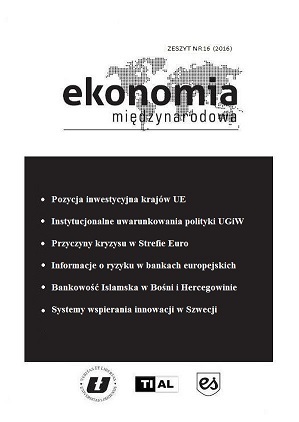Międzynarodowa pozycja inwestycyjna netto krajów Unii Europejskiej w latach 2006–2014
DOI:
https://doi.org/10.18778/2082-4440.16.01Słowa kluczowe:
międzynarodowa pozycja inwestycyjna netto MPI, przepływy kapitałuAbstrakt
Celem opracowania jest próba ocenienia zmian, jeśli chodzi o międzynarodową pozycję inwestycyjną netto45w krajach Unii Europejskiej w latach 2006–2014 w kontekście przestrzegania zaleceń w ramach ogłoszonej procedury zakłóceń makroekonomicznych. W niniejszej pracy dokonano przeglądu najważniejszych koncepcji teoretycznych, będących punktem wyjścia dalszych rozważań. W tym celu przeanalizowano literaturę przedmiotu oraz dane statystyczne dotyczące międzynarodowej pozycji inwestycyjnej krajów w latach 2006–2014. Na tej podstawie spróbowano ocenić współczesne tendencje dotyczące salda netto MPI w UE. W krajach UE występują znaczące różnice w przepływach kapitału mierzonego międzynarodową pozycją netto. Wybuch kryzysu w 2008 r. wywołał zmiany w tendencji w kształtowaniu się struktury kapitału w MPI. W okresie 2006–2014 następuje wzrost absolutnych wartości aktywów oraz pasywów MPI. W większości krajów UE pogłębia się ujemne saldo przepływów finansowych międzynarodowej pozycji inwestycyjnej względem PKB badanych krajów.
Bibliografia
Aizenman J., Pinto B., Radziwill A. (2007), Sources for Financing Domestic Capital – is Foreign Saving a Viable Option for Developing Countries?, „Journal of International Monetary and Finance”, Vol. 26, No. 5.
Google Scholar
DOI: https://doi.org/10.1016/j.jimonfin.2007.04.009
Bhagwati J. (1998), The Capital Myth: The Difference between Trade in Widgets and Dollars, „Foreign Affairs”, Vol. 7, No. 3.
Google Scholar
DOI: https://doi.org/10.2307/20048871
Borensztein E., De Gregorio J., Lee J.-W. (1998), How Does Foreign Direct Investment Affect Economic Growth?, „Journal of International Economics”, Vol. 45.
Google Scholar
Burnside C., Dollar D. (2000), Aid, Policies and Growth, „The American Economic Review”, Vol. 90, No. 4.
Google Scholar
DOI: https://doi.org/10.1257/aer.90.4.847
Cardarelli R., Elekdag S., Kose M.A. (2009), Capital Flows: Macroeconomic Implications and Policy Responses, IMF Working Paper, WP/09/40.
Google Scholar
DOI: https://doi.org/10.5089/9781451871883.001
Catao A.V., Milesi-Ferretti G.M. (2013), External Liabilities and Crises, IMF Working Paper No. 13/113.
Google Scholar
Faria A., Lane P.R., Mauro P., Milesi-Ferretti G.M. (2006), The Shifting Composition of External Liabilities, IIIS Discussion Paper No. 190.
Google Scholar
Feldstein M., Horioka Ch. (1980), Domestic Savings and International Capital Flows, „Economic Journal”, 90/358.
Google Scholar
DOI: https://doi.org/10.2307/2231790
Gourinchas P.-O., Jeanne O. (2006), Capital Flows to Developing Countries: the Allocation Puzzle, NBER Working Paper No. 13602.
Google Scholar
Grabowski W., Maciejczyk-Bujnowicz I. (2016), Verification of the hypothesis „too much finance” in the Polish economy, „Central European Review of Economics and Finance”, Vol. 11, No. 1.
Google Scholar
Gruić B. (2013), Determinants of international investment position, Croatian National Bank, Zagreb.
Google Scholar
DOI: https://doi.org/10.2139/ssrn.2239269
Hausmann R., Fernandez-Arias E. (2001), Is Foreign Direct Investment a Safer Form of Financing?, „Emerging Markets Review”, Vol. 2, No. 1.
Google Scholar
DOI: https://doi.org/10.1016/S1566-0141(00)00018-2
Johnson S., Ostry J., Subramanian A. (2007), The Prospects for Sustained Growth in Africa: Benchmarking the Constraints, IMF Working Paper, WP 07/52.
Google Scholar
DOI: https://doi.org/10.5089/9781451866162.001
Kose M.A., Prasad E., Rogoff K., Wei S.-J. (2006), Financial Globalisation: A Reappraisal, NBER Working Paper No. 12484.
Google Scholar
Lucas R. (1990), Why Doesn’t Capital Flow from Rich to Poor Countries, „American Economic Review”, No. 80.
Google Scholar
Maciejczyk-Bujnowicz I. (2015), Changes in capital flows in process of integration of the European Union – selected aspects [w:] Sokołowski J., Węgrzyn G., Rękas M. (red.), Prace Naukowe Uniwersytetu Ekonomicznego we Wrocławiu, nr 401, Wrocław.
Google Scholar
DOI: https://doi.org/10.15611/pn.2015.401.23
Mody A., Murshid A.P. (2011), Growth from International Capital Flows: The Role of Volatility Regimes, IMF Working Paper 11/90.
Google Scholar
DOI: https://doi.org/10.5089/9781455253296.001
Prasad E., Rajan R., Subramanian A. (2006a), Patterns of International Capital Flows and their Implications for Economic Development, referat zaprezentowany podczas sympozjum „The New Economic Geography: Effects and Policy Implications”, Federal Reserve Bank of Kansas City, Jackson Hole, Wyoming, 24–26 sierpnia 2006 r.
Google Scholar
Prasad E., Rajan R., Subramanian A. (2006b), Foreign Capital and Economic Growth, IZA Discussion Paper No. 3186.
Google Scholar
DOI: https://doi.org/10.3386/w13619
Rajan R., Subramanian A. (2005), What Undermines Aid’s Impact on Growth, „American Economic Review”, Vol. 88, No. 3.
Google Scholar
DOI: https://doi.org/10.3386/w11657
Rodrik D. (1998), Who Needs Capital-Account Convertibility?, Essays in Interantional Finance, No. 207, Princeton, NJ: Princeton University.
Google Scholar
Stiglitz J. (2000), Capital Market Liberalization, Economic Growth, and Instability, „World Development”, Vol. 28, No. 6.
Google Scholar
DOI: https://doi.org/10.1016/S0305-750X(00)00006-1
TFUE, Traktat o Funkcjonowaniu Unii Europejskiej (wersja skonsolidowana), Dz. Urz. UE z dnia 26 października 2012 r. C326/01, ze zm.
Google Scholar
TUE, Traktat o Unii Europejskiej (wersja skonsolidowana), Dz. Urz. UE z dnia 26 października 2012 r. C326/01, ze zm.
Google Scholar
Pobrania
Opublikowane
Jak cytować
Numer
Dział
Licencja

Utwór dostępny jest na licencji Creative Commons Uznanie autorstwa – Użycie niekomercyjne – Bez utworów zależnych 4.0 Międzynarodowe.









